A game for players with low vision including those with cortical visual impairment (CVI)
Guidelines for Use
Project Staff
Linda Almasy Hohmann, Consultant
Janet Jerpe, Consultant
Karen Rizzo, Consultant
Rosanne Hoffmann, Project Leader
Christine Roman-Lantzy, Project Leader
Denise Snow Wilson, Research Assistant
Frank Hayden, Technical Research & Model Shop Division Manager
Bryan Rogers, Manufacturing Specialist
Anthony Slowinski, Graphic Design
InGrid Design, Photography
Catalog Number 0-08157-00
Copyright ©2014 by the American Printing House for the Blind, all rights reserved.
Printed in the United States of America.
This publication is protected by Copyright and permission should be obtained from the publisher prior to any reproduction, storage in a retrieval system, or transmission in any form or by any means electronic, mechanical, photocopying, recording, or otherwise. For information regarding permission, contact the publisher at the following address:
American Printing House for the Blind
1839 Frankfort Ave.
Louisville, KY 40206
800-223-1839
www.aph.org or info@aph.org
Reference citation:
Roman-Lantzy, C. & Hoffmann, R. (2014) Match Sticks Guidelines for Use. Louisville, KY: American Printing House for the Blind.
Acknowledgements
The following field testers and their students provided valuable time and input during the development of MATCH STICKS: Susan Adams, Meg Allen, Kathy Alstrin, Johanna Anand, Cristina Di Lullo, Sharle Hussion, Tami Johnson, Elizabeth Lawlor, Anne Nielson, Lynn Pensari, Karen M. Shelley, Connie Smith, Diane Stockman, Jennifer Wheeler, and Anzer Woodward.
Introduction
Many products are currently available for the assessment and education of individuals with visual impairments, but most of these items do not translate well into leisure time activities. MATCH STICKS is designed to fill this gap and provide an alternative activity for these individuals ─ particularly those with CVI ─ in the form of a game. Individuals with CVI typically have a normal eye exam but their vision is impaired due to damage to the part of their brain involved in the processing of visual information. With proper intervention, it is possible for many visual behaviors associated with CVI to resolve, resulting in improved vision. MATCH STICKS is a game that sharpens visual skills in a fun and entertaining way. The reference cited in this booklet provides detailed information about assessment of individuals with CVI and appropriate interventions.
Use the guidelines in the following sections to determine whether MATCH STICKS is an appropriate game for a particular student or child and to assist in selecting the type of sticks with which to play.
Prerequisites
Play MATCH STICKS with individuals who
- are at least five years of age;
- may have a diagnosis of CVI and demonstrate the unique visual and behavioral characteristics associated with CVI;
- are in Phase II or Phase III of the CVI Range Assessment;
- are visually attentive to bright colors on a three-dimensional object;
- are able to recognize or discriminate a particular color when presented among other colors;
- have emerging matching skills;
- are able to utilize their vision in a semicontrolled environment;
- recognize salient features presented on a low complexity background, as on Phase II and Phase II Advanced sticks;
- recognize salient features presented on a complex background, as on Phase III sticks.
Rationale
Consider the following rationale to support the use of each set of MATCH STICKS as follows:
Phase II MATCH STICKS have a long, brightly colored stripe on a noncomplex black background. This combination allows individuals who score in the beginning of Phase II on the CVI Range to establish and maintain their ability to demonstrate consistent visual responses.

Phase II Advanced MATCH STICKS have a medium length, brightly colored stripe on a black and white patterned background. Introducing complexity to the background visually challenges the individual who scores toward the end of Phase II on the CVI Range. These individuals will need to identify the salient feature on this low complexity background.

Phase III MATCH STICKS have a short, brightly colored stripe on a complex multicolored background. Difficulty with visual complexity is often the most challenging of the CVI characteristics to resolve. Therefore, this set is meant for individuals who are ready to be challenged to locate salient features on patterns of increased complexity.

Goals
The MATCH STICKS game is designed for individuals with CVI to improve their ability to
- recognize or identify a single color (salient feature) on a low complexity background among other colors on low complexity backgrounds;
- match a single color (salient feature) on a low complexity background;
- recognize or identify a single color (salient feature) on a complex background among other colors on complex backgrounds;
- match a single color (salient feature) on a complex background;
- practice a visually guided reach for targets on both low complexity and complex backgrounds; and
- locate targets in a variety of visual fields.
Game Components
Three Sets of MATCH STICKS
Each MATCH STICK has a different color stripe of equal length on each side printed on a particular background. In each set of different backgrounds, the color pairings of the stripes are red-pink, blue-yellow, yellow-red, and pink-blue.

Phase II MATCH STICKS
Twenty sticks
Five red-pink, five blue-yellow, five yellow-red, and five pink-blue long stripes on a black background
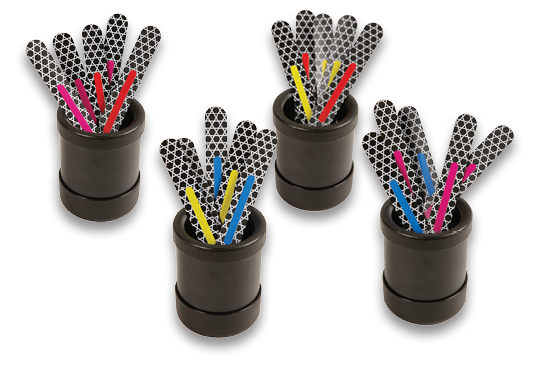
Phase II Advanced MATCH STICKS
Twenty sticks
Five red-pink, five blue-yellow, five yellow-red, and five pink-blue medium stripes on a black and white patterned background
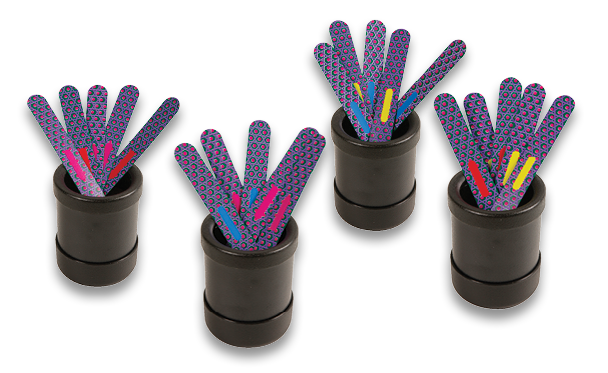
Phase III MATCH STICKS
Twenty sticks
Five red-pink, five blue-yellow, five yellow-red, and five pink-blue short stripes on a complex multicolored background
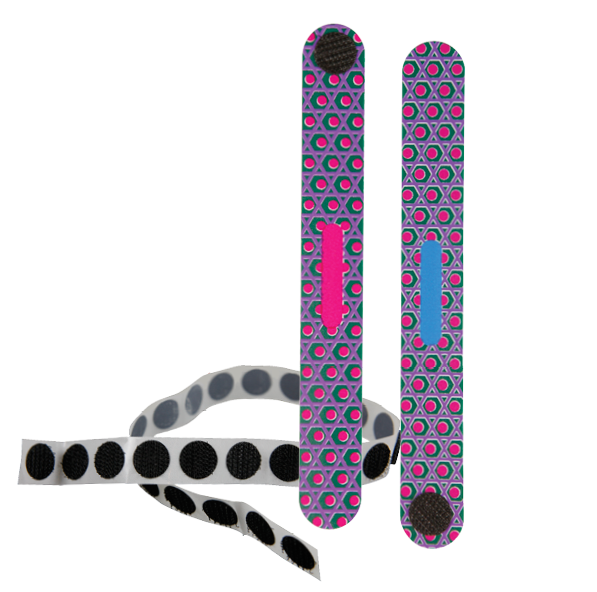
Hook Adhesive Dots
Apply the black, half-inch hook adhesive dots to the MATCH STICKS only if attachment to a felt or loop surface such as the APH Invisiboard is desired. Apply an adhesive dot (whole or cut in half) to opposite sides of each tip. Removal of the green liner from the cylindrical container is recommended to prevent MATCH STICKS from sticking to the cylindrical cup.
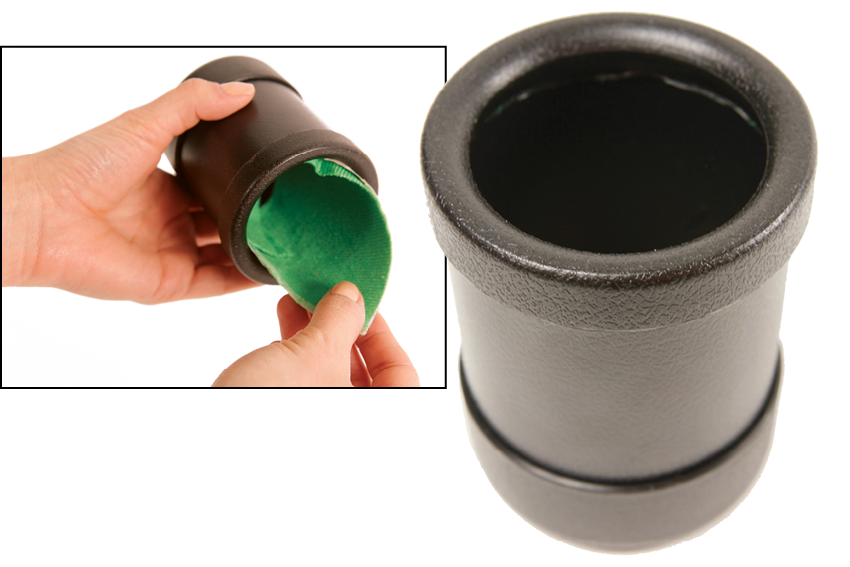
Cylindrical Cup
- Use this to hold play sticks if desired.
- Remove the inner lining of the cup to prevent the hook adhesive dots on the MATCH STICKS from adhering to it.
Game Directions
Suggested APH Products to Use with MATCH STICKS
Display surfaces for sticks with hook adhesive dots
- All-In-One Board Catalog number 1-08836-00
- All-In-One Board: Student Model Catalog number 1-08833-00
- Invisiboard Catalog number 1-08541-00
- Tri-fold Board Catalog number 1-08859-00
- Felt Board Catalog number 61-314-026
Play surface on which to drop or display sticks
- Small, black Work-Play Tray Catalog number 1-03751-00
- Small, yellow Work-Play Tray Catalog number 1-03660-00
- Large, black Work-Play Tray Catalog number 1-03761-00
- Large, yellow Work-Play Tray Catalog number 1-03740-00
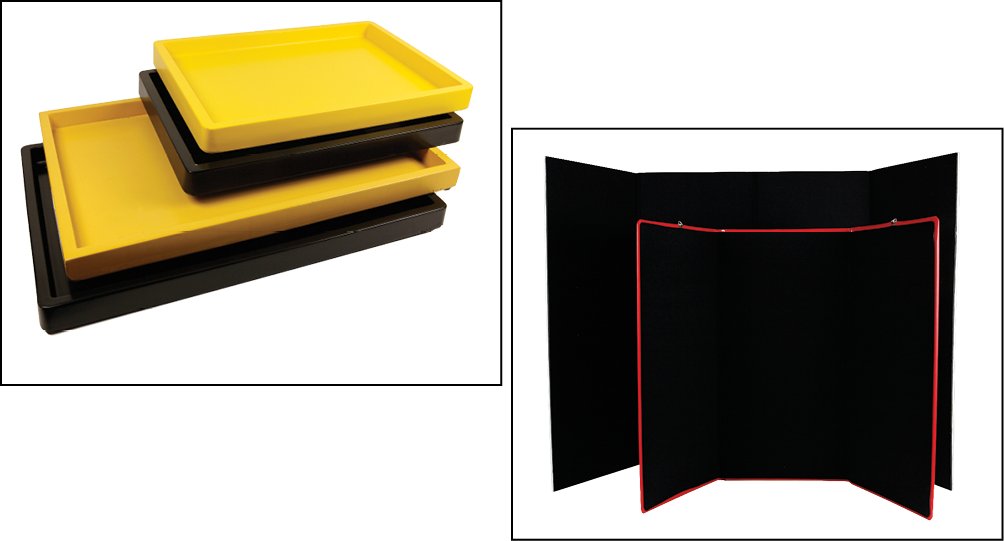
Object of the Game
To be the first player to obtain four play sticks that match the target stick.
The following routines may require adult assistance and/or modification according to the abilities of the players. Bulleted modifications are included in some steps.
Set-up for Two to Four Players
- It is recommended that each player have a display surface such as an APH All-In-One Board, and/or a play surface such as an APH Work-Play Tray.
- Select the appropriate set of sticks: Phase II, Phase II Advanced, or Phase III.
- Attach hook adhesive dots as needed to each MATCH STICK (please see description of hook adhesive dots in Game Components section).
- Each player selects a different color target stick from the four possible colors and places it on a display or play surface. The remaining sticks are the play sticks.
- Place the play sticks into the cylindrical cup.

Let’s Play
- The first player randomly selects and grasps three play sticks from the cylindrical cup. The player opens her hand to release the three play sticks onto the play surface.
- An adult randomly chooses and places one or more play sticks into the cup for the player to grasp and drop onto the play surface.
- An adult randomly chooses one play stick at a time and places it in front of a player.
- The player visually locates and picks up each play stick that
matches the target stick.
- Modification:
- A player may point to or reach toward a matching play stick if they are unable to pick it up.
- The player places any matching play sticks next to the target
stick on the play surface or the display board.
- Modification:
- An adult can place the matching sticks in the proper location for the player.
- Place all nonmatching sticks back into the cylindrical cup and proceed to the next player.
- The winner is the first player to collect four matching play sticks.

- Modifications:

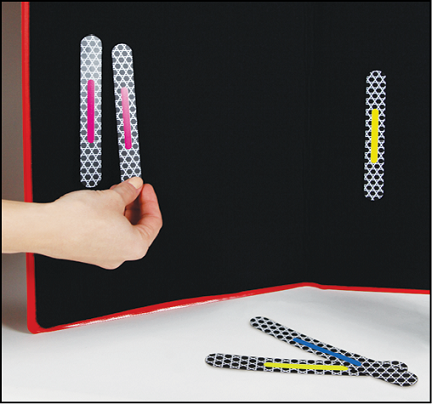
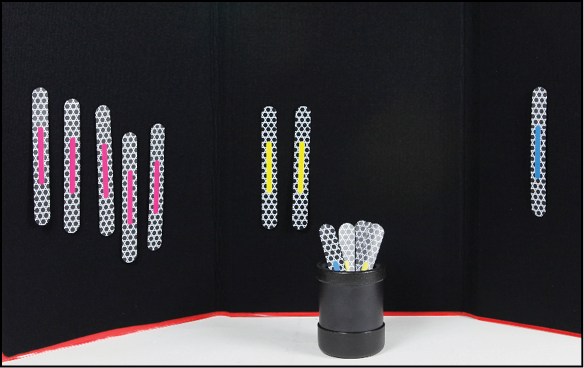
Alternate Play Options
- Allow players to find a match to their target stick from two or three colors of play sticks rather than from four.
- After choosing a target stick, ask the player to choose one play stick at a time from an array of sticks and determine whether it matches the target stick.
- Place three random play sticks on the display board and place the target stick nearby. Then ask the player to point to or pull off any matching (or nonmatching) sticks from the board.
- Use different color play surfaces and display boards, such as white or yellow.
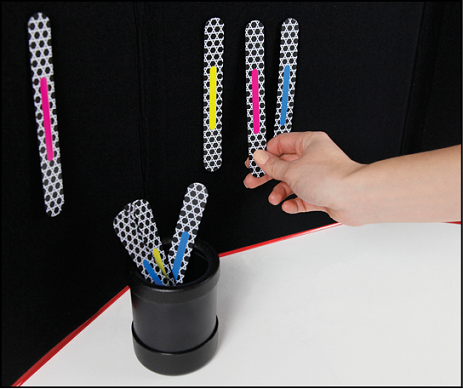
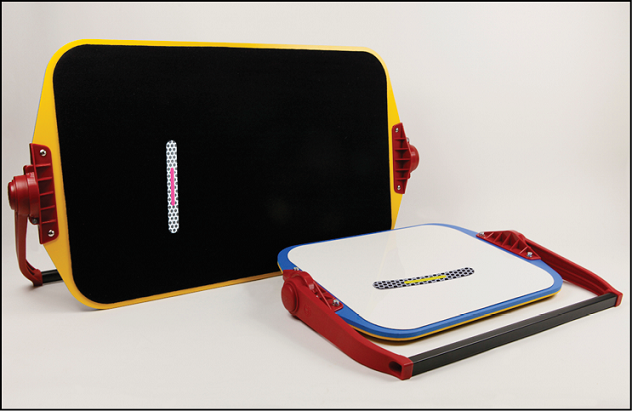
Reference
Roman-Lantzy, C. (2007). Cortical visual impairment: An approach to assessment and intervention. New York, NY: AFB Press.

American Printing House for the Blind
Catalog Number 0-08157-00
Copyright © 2014
American Printing House for the Blind, Inc.
1839 Frankfort Ave.
P.O. Box 6085
Louisville, KY 40206
Toll Free: 800-223-1839
Fax: 502-899-2284
Web site:
www.aph.org